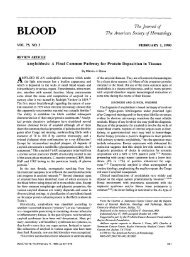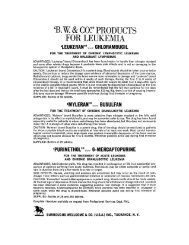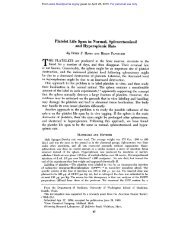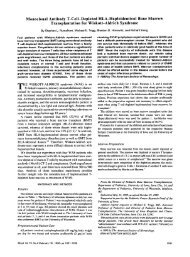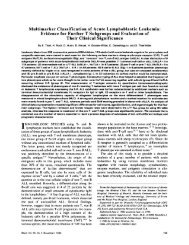View - Blood
View - Blood
View - Blood
Create successful ePaper yourself
Turn your PDF publications into a flip-book with our unique Google optimized e-Paper software.
From www.bloodjournal.org by guest on April 28, 2015. For personal use only.<br />
Acid Phosphatase Activity in Auer Bodies<br />
By ARmuii F. GOLDBERG<br />
UER BODIES and leukocyte granules appear to be closely related<br />
structures, on the basis of similarities found in electron microscopi&’2<br />
and histochemical stildies.3’4 One of the enzymes which can be demonstrated<br />
in leukocyte granules both by histochemical5’6’7 and biochemical<br />
methods8’#{176} is acid phosphatase. Because we considered Auer bodies to be<br />
abnormal granules, this study was undertaken to see if acid phosphatase<br />
activity would also be found in this organelle just as it had been demonstrated<br />
in leukocyte granules. The presence of an enzyme common to both<br />
structures could be further favorable evidence of the similarities between<br />
them.<br />
MATERIAL AND METhODS<br />
Peripheral blood smears stained with Romanowsky-type dyes were obtained from three<br />
patients who had Auer bodies present in some of their peripheral leukocytes. Two patients<br />
had acute myeloblastic leukemia and one myelo-monocytic leukemia. Slides were<br />
stained for acid phosphatase activity with a slightly modified Gomori method.1#{176} Alkaline<br />
phosphatase activity was demonstrated by Kaplow’s technic.11 Other slides were stained<br />
with Jenner-Giemsa at pH 6.8.<br />
Gomori’s method was employed on smears of peripheral blood, air dried and fixed for<br />
16 to 24 hours at 4 C. in 10 per cent neutral formalin-acetate ( 0.1 M sodium acetate =<br />
900 ml., 40 per cent formalin = 100 ml. adjusted to pH 7.0). Slides were washed with<br />
distilled water and placed into a Coplin jar containing the incubation medium, for 6 hours<br />
at 37 C. The incubation medium was made in the following manner: Solution A: 0.2 M<br />
sodium acetate buffer at pH 5.0 (300 ml. of 0.6 per cent glacial acetic acid was added to<br />
700 ml. of solution containing 27 Cm. sodium acetate 3 H.,O in 1000 ml. distilled water).<br />
Solution B: 0.05 M acetate buffer at pH 5.0 ( 0.6 Gm. of lead nitrate was added to 12<br />
ml. of solution A and made up to 500 ml. with distilled water). Incubation medium: 5 ml.<br />
of freshly prepared 3 per cent sodium glycerophosphate#{176} ( 40 per cent a, 60 per cent $)<br />
was added to solution B. A fine precipitate forms which must be filtered.<br />
Control slides were incubated in a medium omitting the glycerophosphate. After incubation,<br />
slides were washed with distilled water 4 times, placed for 1 minute in dilute<br />
acetic acid ( 0. 1 per cent ) to eliminate nonspecific bound lead, and then washed again.<br />
The final reaction product, lead sulfide was subsequently visualized after treatment in<br />
1 per cent aqueous ammonium sulfide for 3 minutes. Smears were washed in distilled<br />
water, counterstained in dilute Harris’ hematoxylin ( 1 : 20 ) for 5 minutes and washed<br />
again. They were then either mounted in Glycerogel or dehydrated through alcohols and<br />
xylene and mounted in Permount. No artifactual nuclear staining was seen either in the<br />
From the Department of Medicine (Hematology), Hospital for Joint Diseases, New York,<br />
N. Y. and the Department of Medicine, New York University School of Medicine,<br />
New York, N. Y. Work was initiated in the Department of Hematology, Mount SMai<br />
Hospital, N. Y., N. Y.<br />
This study was suppartel in part by PHS Research Gran.t CA-071 78-02 from the National<br />
Cancer<br />
Institute.<br />
Submitted Aug. 29, 1963; accepted for publication Feb. 7, 1964.<br />
#{176}Mann Research Laboratories, New York 6, N. Y.<br />
305<br />
BLoon, VOL. 24, No. 3 (SEPTEMBER), 1964
From www.bloodjournal.org by guest on April 28, 2015. For personal use only.<br />
306 ARTHUR F. GOLDBERG<br />
control or test uncounter-stained preparations even after 9 hours incubation. Other control<br />
smears incubated for 10 minutes at 97 C. showed no phosphatase activity. Initially<br />
prolonged fixation times were used and thus a long incubation time was required to pro-<br />
(111Cc satisfactory activity. If shorter fixation times were employed, a much shorter incubation<br />
demonstrated similar enzyme sites.<br />
RESULTS AND DISCUSSION<br />
With Gomori’s method, acid phosphatase activity was detected in Auer<br />
bodies ( fig. 1 a-d ) . Intermediate forms between fully developed Auer rods<br />
and typical spherical granules were similarly demonstrated ( fig. id ) . Marked<br />
variations in the shape of Auer bodies and the presence of transitional forms<br />
between Auer bodies and granules have been recognized using other technics.’3’2<br />
Gomori’s method permits the fine localization of acid phosphatase<br />
activity clearly delineating the shape of the Auer bodies similar to that seen<br />
with other methods under the light microscope as well as in the electron<br />
microscope.<br />
Ackerman, also using the lead salt method, could not demonstrate this<br />
enzyme in Auer bodies. In another early study, however, Harada4 showed<br />
with Gomori’s method that some Auer bodies stained positively for acid<br />
phosphatase activity.<br />
It is felt that the Auer body may he a grossly abnormal, elongated leukocyte<br />
granule, although it may develop from the fusion of smaller ones. Normally,<br />
immature myeloid cells contain very few elongated granules.’3 Most of the<br />
granules present are spherical. The predominant ones in mature polymorphonuclear<br />
leukocytes are elongated. The presence of an exaggerated structure<br />
such as the Aiter body in immature cells may represent another manifestation<br />
of the asynchronous maturation and development of specific granules<br />
in leukemic cells. In preliminary observations with electron cytochemistry of<br />
normal leukocytes, acid phosphatase activity has been demonstrated in both<br />
the elongated and spherical granules of polymorphonuclear leukocytes.14<br />
Acid phosphatase along with a series of other acid hydrolases, has been<br />
found in a newly described subcellular particle called the lysosome.15”8<br />
Leukocyte granules are considered to be such structures.5’8 The presence of<br />
an acid hydrolase associated with lysosomes, as well as other reported morphologic<br />
and cytochemical similarities between Auer bodies and leukocytic<br />
granules, supports the concept that Auer bodies may be abnormally shaped<br />
granules. The Auer body could thus be an abnormal lysosome in a<br />
plastic cell and would probably also contain the other acid hydrolases<br />
found in leukocyte granules.<br />
Using an azo-dye method, no alkaline phosphatase activity was found in<br />
younger myeloid cells. None was present in Auer bodies. Similar results were<br />
found by Ackerman1 using Gomori’s method for alkaline phosphatase. Harada,4<br />
however, described Auer bodies as exhibiting a positive reaction for<br />
alkaline phosphatase. We consider that these structures were probably falsely<br />
stained due to diffusion artifacts)7 One may conjecture that while acid<br />
phosphatase is present in Auer bodies, the absence of alkaline phosphatase<br />
may be indirect evidence that this enzyme resides in a different organelle<br />
from the granule containing acid phosphatase in mature leukocytes.
From www.bloodjournal.org by guest on April 28, 2015. For personal use only.<br />
ACID PHOSPHATASE ACTIVITY IN AUER BODIES 307<br />
a<br />
b<br />
t<br />
1 #{149}<br />
‘\ Cd<br />
- Fig. i.-Periphe;al leukemic cells stained for acid phosphatase activity b the<br />
lead salt method of Gomori ( original magnification 1 000 X, enlarged to 10,000 X).<br />
( a ) Acid phosphatase acti’itv in Auer body ( arrow ) of leukemic mveloblast.<br />
A smaller Auer body overlies the larger one. Because of the three dimensional<br />
nature of the preparation, it, as well as the nucleus and some granules, lie in<br />
another cellular pliiie. At opposite pole, activity in granules is present. ( b ) Same<br />
cell as in (a) viewed in modified clark field with microscope condenser lowered.<br />
Auer body and granules appear as discrete crystalline-like structures. ( c ) Leukemic<br />
ptnyelo-moiocyte with acid phosphatase activity distributed diffusely in granules<br />
and Auer body ( arrow ) . (d ) Leukemic promvelo-inonocvte with small Auer body<br />
(arrow) . Two other Auer bodies situated at 1)0th its poles are more vertically<br />
oriented. Activity is also present in varial)l\ size(l granules.<br />
SUMMARY<br />
Employing the Gomori lead salt method ( pH 5.0) , acid phosphatase activitv<br />
was demonstrated in Auer bodies. The presence of this enzyme<br />
may be considered further evidence of the similarity between leukocyte<br />
granules, known to contain acid phosphatase, and this structure. No alkaline<br />
phosphatase activity was exhibited in these bodies. The significance of these<br />
findings is discussed.
From www.bloodjournal.org by guest on April 28, 2015. For personal use only.<br />
308 ARTHUR F. GOLDBERG<br />
SUMMARIO IN INTERLINGUA<br />
Con le uso del methodo de Gomori a sal de plumbo (pH 5,0), le activitate<br />
de phosphatase acide esseva demonstrate in corpores de Auer. Le presentia de<br />
iste enzyma pote esser considerate como un evidentia additional pro le similitude<br />
inter le granulos leucocytic e le corpores de Auer. Nulle activitate de<br />
phosphatase alcalin esseva trovate in le corpores de Auer. Le signification de<br />
iste constatationes es discutite.<br />
REFERENCES<br />
1. Freeman, J. A. : The ultrastructure and<br />
genesis of Auer bodies. <strong>Blood</strong> 15:<br />
449-465, 1960.<br />
2. Bessis, M., and Thi#{233}ry, J. P.: Etudes au<br />
microscope #{233}lectronique sur les leuc#{233}mies<br />
humaines. I. Les leuc#{233}mies<br />
granulocytaires. N. Rev. franc. d’<br />
H#{233}mat. 5:703-728, 1961.<br />
3. Ackerman, C. A. : Microscopic and<br />
histochemical studies on the Auer<br />
bodies in leukemic cells. <strong>Blood</strong> 5:<br />
847-863, 1950.<br />
4. Harada, N. : Histochemical studies on<br />
the Auer body. Nagoya J. Med. Sc.<br />
14:129-134, 1951.<br />
5. Goldberg, A. F. : Acid phosphatase in<br />
leukocytes of normals, patients with<br />
toxi-infectious states, infectious mononucleosis,<br />
eosinophilias and Auer<br />
bodies. Fed. Proc. 21:74d, 1962.<br />
6. -, and Barka, T. : Acid phosphatase<br />
activity in human blood cells. Nature<br />
195:297, 1962.<br />
7. L#{246}ffler, H., and Berghoff, W. : Eine<br />
Methode zum Nachweis von saurer<br />
Phosphatase in Ausstrichen. Klin.<br />
Wchnschr. 40:363-364, 1962.<br />
8. Cohn, Z. A., and Hirsch, J. C.: The<br />
isolation and properties of specific<br />
cytoplasmic granules of rabbit polymorphonuclear<br />
leukocytes. J. Exper.<br />
Med. 112:983-1004, 1960.<br />
9. Kawabata, S.: A study on the isolated<br />
granules of leucocyte by cytochemical<br />
stainings. Nagoya J. Med. Sc. 22:<br />
396-411, 1959-1960.<br />
10. Gomori, C.: Microscopic Histochemistry:<br />
Principles and Practice. Chicago,<br />
Ill., Univ. Chicago Press, 1952.<br />
1 1. Kaplow, L. S. : A histochemical procedure<br />
of localizing and evaluating<br />
leucocyte alkaline phosphatase activity<br />
in smears and bone marrow.<br />
<strong>Blood</strong> 10:1023-1029, 1955.<br />
12. Bessis, M. : Etiudes siur les cellules des<br />
leuc#{233}mies et des myelomes au microscope<br />
a contrast de phase et par la<br />
m#{233}thode de l’ombrage (avec une<br />
#{233}tude particuli#{232}re des corps d’Auer<br />
et de la formation des cellules de<br />
Reider). Rev. d’H#{233}matol. 4:364-394,<br />
1949.<br />
13. -, and Thi#{233}ry, J. P. : Electron microscopy<br />
of the human blood cells and<br />
their stem cells. Inter. Rev. Cytol.,<br />
vol. 12, New York, Academic Press,<br />
1961, pp. 199-241.<br />
14. Ghidoni, J. J., and Coldberg, A. F.:<br />
Unpublished<br />
observations.<br />
15. de Duve, C. : The lysosomes. In Subcellular<br />
Particles. T. Hayashi, ed.<br />
New York, Ronald Press, 1959, pp.<br />
128-159.<br />
16. Novikoff, A. B.: Lysosomes and related<br />
particles. In The Cell. vol. II, J.<br />
Brachet, and A. E. Mirsky, ed. New<br />
York, Academic Press, 1961, pp. 423-<br />
488.<br />
17. Deane, H. W., Barrnett, R. J., and<br />
Seligman, A. M.: Enzymes. vol. VII.<br />
In Handbuch der Histochemie. Stuttgart,<br />
Gustav Fisher Verlag, 1960,<br />
pp. 70-74.<br />
Arthur F. Goldberg, M.D., Ad/unct in General Medicine<br />
(Hematology), Hospital for Joint Diseases; Instructor in Clinical<br />
Medicine, Department of Medicine, New York University<br />
School of Medicine, New York, N. Y.
From www.bloodjournal.org by guest on April 28, 2015. For personal use only.<br />
1964 24: 305-308<br />
Acid Phosphatase Activity in Auer Bodies<br />
ARTHUR F. GOLDBERG<br />
Updated information and services can be found at:<br />
http://www.bloodjournal.org/content/24/3/305.full.html<br />
Articles on similar topics can be found in the following <strong>Blood</strong> collections<br />
Information about reproducing this article in parts or in its entirety may be found online at:<br />
http://www.bloodjournal.org/site/misc/rights.xhtml#repub_requests<br />
Information about ordering reprints may be found online at:<br />
http://www.bloodjournal.org/site/misc/rights.xhtml#reprints<br />
Information about subscriptions and ASH membership may be found online at:<br />
http://www.bloodjournal.org/site/subscriptions/index.xhtml<br />
<strong>Blood</strong> (print ISSN 0006-4971, online ISSN 1528-0020), is published weekly by the American Society of<br />
Hematology, 2021 L St, NW, Suite 900, Washington DC 20036.<br />
Copyright 2011 by The American Society of Hematology; all rights reserved.



